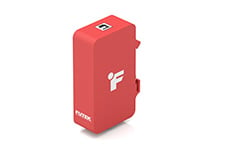How to measure torque of a motor?
A relatively simple method to estimate electrical motor torque (AC - Synchronous or Induction; or DC - Brushed or Brushless) is to measure its electrical power input, the voltage and the current in the power line driving the motor. For most motors, torque is directly proportional to the current and can be derived from it by knowing shaft speed and motor efficiency. This is considered an indirect measurement of torque since it is not the true mechanical torque but instead a relation from electrical power quantities to a theoretical and estimated torque value.
Another alternative and indirect method is to create a transversal arm attached to the motor housing using a known arm length. Let the whole motor housing outside case run freely along the attached arm. The arm tip can then be placed on a load cell. The torque can now be measured using a load cell measurement and the arm length.
However, for a precise and accurate shaft output torque measurement, a rotary torque sensor is the recommended method. Rotary Torque Sensors are frequently used as auditing tools for motor torque testing stand in motors, power tools, turbines, and generators.
In some instances, the user wants to measure the electric motor output power. In that case, one may want to use a rotary torque sensor with encoder and a Universal Signal conditioner to read both torque and angular speed (RPM). Check out this application note on how to measure the electric motor output power.
How it Works
FUTEK's TRS Series is an effective tool for motor torque testing/auditing, feedback control, monitoring torque, and analyzing the efficiency of test stands.
In this application, the TRS Rotary Motor Reaction Torque Sensor is coupled between an eddy brake and motor.
As the motor rotates, the TRS Motor Torque Sensor measures the torque produced by the motor in response to the load generated by the brake.
FUTEK developed certain models of the TRS Series with built-in encoders. These encoders measure the angle/speed produced during this test.
Torsion measurements can successfully be monitored on a digital display, such as FUTEK's IPM650 Panel Mount Display or SensLog Handheld Display, or streamed to a PC using FUTEK's USB520.
The USB520 is the ideal data exchange solution for systems that require translation of rotary torque encoder readings, such as angle and speed. Its compact and robust design also makes the USB520 fitting for this type of industrial application.
Applying FUTEK's SENSIT™ Test and Measurement Software to this test platform will allow the operator to live graph and data log the results.
Products in Use
One Rotary Torque Sensor (TRS Series) paired with Instrumentation (IPM650, SensLog Handheld Display or USB520).
Contact Us
Please Contact Us with questions.
How to measure torque of a motor?
A relatively simple method to estimate electrical motor torque (AC - Synchronous or Induction; or DC - Brushed or Brushless) is to measure its electrical power input, the voltage and the current in the power line driving the motor. For most motors, torque is directly proportional to the current and can be derived from it by knowing shaft speed and motor efficiency. This is considered an indirect measurement of torque since it is not the true mechanical torque but instead a relation from electrical power quantities to a theoretical and estimated torque value.
Another alternative and indirect method is to create a transversal arm attached to the motor housing using a known arm length. Let the whole motor housing outside case run freely along the attached arm. The arm tip can then be placed on a load cell. The torque can now be measured using a load cell measurement and the arm length.
However, for a precise and accurate shaft output torque measurement, a rotary torque sensor is the recommended method. Rotary Torque Sensors are frequently used as auditing tools for motor torque testing stand in motors, power tools, turbines, and generators.
In some instances, the user wants to measure the electric motor output power. In that case, one may want to use a rotary torque sensor with encoder and a Universal Signal conditioner to read both torque and angular speed (RPM). Check out this application note on how to measure the electric motor output power.




